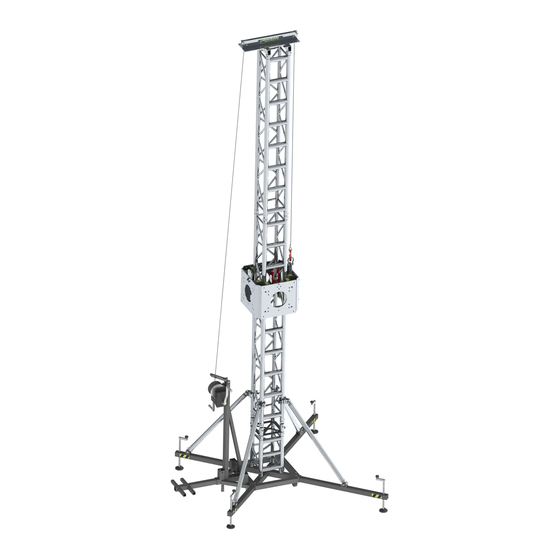
Table of Contents
Advertisement
Available languages
Available languages
Quick Links
LIFTING TOWERS
TRC-700
TRC-700
Instrucciones
Instructions
Nº de serie:
Nº de serie:
Serial No.:
Fabricante:
Manufacturer:
FENIX Stage, S.L.U.
FENIX Stage, S.L.U.
Avda. de los Trabajadores, 24
Horno de Alcedo
46026 - Valencia (Spain)
Tel.: +34 96 125 08 55
export@fenixstage.com
www.fenixstage.com
www.fenixstage.com
Advertisement
Table of Contents

Summary of Contents for Fenix TRC-700
- Page 1 TRC-700 Instrucciones Instructions Nº de serie: Nº de serie: Serial No.: Fabricante: Manufacturer: FENIX Stage, S.L.U. FENIX Stage, S.L.U. Avda. de los Trabajadores, 24 Horno de Alcedo 46026 - Valencia (Spain) Tel.: +34 96 125 08 55 export@fenixstage.com www.fenixstage.com www.fenixstage.com...
- Page 2 DECLARATION OF CONFORMITY FENIX STAGE S.L.U. Adress: Avda. de los Trabajadores, 24 - Horno de Alcedo - 46026 - Valencia (Spain) Phone/fax: +34 96 125 08 55 / +34 96 125 13 05 VAT No.: ESB-91423046 We declare at our exclusive liability the conformity of the product:...
-
Page 3: Table Of Contents
ÍNDICE 1.- INTRODUCCIÓN 2.- DATOS GENERALES 2.1.- Datos técnicos 2.2.- Normativa de aplicación 3.- NORMAS DE SEGURIDAD 4.- INSTRUCCIONES DE USO 5.- MANTENIMIENTO 6.- RIESGOS ESPECÍFICOS 7.- SISTEMAS DE PREVENCIÓN INDEX 1.- INTRODUCTION 2.- GENERAL DATA 2.1.- Technical data 2.2.- Applicable regulations 3.- GENERAL SAFETY RULES 4.- HOW TO USE 5.- MAINTENANCE... -
Page 4: Introducción
TRC-700 Anclaje de las patas por gatillos de seguridad. Descripción del equipo: La torre estructural TRC-700 ha sido diseñada para levantar estructuras y aparatos de iluminación y sonido en sentido vertical a diferentes alturas. -
Page 5: Normas De Seguridad
ESPAÑOL 3. NORMAS GENERALES DE SEGURIDAD - La torre estructural es un elemento industrial diseñado para la elevación de cargas en sentido vertical, nunca se debe utilizar como plataforma estructural de personas. - Colocar la torre estructural sólo en superficies duras y planas, verificando que está en posición vertical. -
Page 6: Instrucciones De Uso
ESPAÑOL 4. INSTRUCCIONES DE USO 4. Sacar el contrapeso (P) de su posición e insertar en su alojamiento de trabajo (N) 1. Colocar la torre estructural sobre una usando el pasador (F). superficie plana y firme en su emplazamiento de trabajo. 5. - Page 7 ESPAÑOL 7. Deslizar el cable (H), pasarlo por las poleas (O) del cabezal (V) y enganchar el gancho (J) en el aro de la plancha (I). Elevar la torre estructural girando la manivela del cabestrante (M) y una vez todos los trusses estén en posición vertical, conectar el truss (T1) a las bisagras traseras (Q) con sus respectivos pasadores.
-
Page 8: Mantenimiento
ESPAÑOL 5. MANTENIMIENTO 6. RIESGOS ESPECÍFICOS Fallo del sistema de freno 1. Comprobar periódicamente el estado del cable. Si un cable presenta rotura de hilos o aplastamiento, debe ser sustituido Puede producirse por deficiencias en inmediatamente por otro nuevo. No utilizar el sistema de frenado o por una mala la torre estructural con cables en mal estado. -
Page 9: Sistemas De Prevención
ESPAÑOL 7. SISTEMAS DE PREVENCIÓN Sobre fallo del sistema de freno Disponer de cabestrante conforme a la norma BGV D8 y 2006/42 CE. Sobre pérdida de estabilidad El mantenimiento de la estabilidad de la torre estructural debe realizarse básicamente con las siguientes medidas: •... -
Page 10: Introduction
Fixation of tower sections to working height with safety pins. Leg anchorage with safety pins. Equipment description: Ground support tower TRC-700 has been designed to vertically raise structures and lighting and sound equipment vertically to different heights. Tested by skilled personnel having passed all the operating, maximum load and dimension inspections. -
Page 11: General Safety Rules
ENGLISH 3. GENERAL SAFETY RULES - The lifting tower is an industrial element designed to raise loads vertically, it must NEVER be used as a platform elevator for people. - Only place the lifting tower on firm flat grounds checking it is in vertical position. Do not use wedges or any strange elements to balance the hoist. -
Page 12: How To Use
ENGLISH 4. HOW TO USE 4. Remove the counterweight (P) from 1. Place the ground support tower over a firm its position and insert it into its working and flat surface on its working place. position (N) using the pin (F). 2. - Page 13 ENGLISH 7. Slide the cable (H), pass it through the pulleys (O) of the head (V) and hook the hook (J) into the ring of the plate (I). Lift the ground support tower by turning the winch handle (M) and once all the trusses are in vertical position, connect the truss (T1) to the rear hinges (Q) with their respective pins.
-
Page 14: Maintenance
Knocks and/or contusions due to objects 3. Ground support tower TRC-700, must be This risk only occasionally causes an accident checked by an expert a minimum of once a to the worker running the operation due to year as per its use. -
Page 15: Prevention Systems
ENGLISH 7. PREVENTION SYSTEMS About braking system failure Equip with winch according to BGV D8 y 2006/42 CE directive. About loss of stability Maintenance of ground support tower stability must basically be as per the following measures: • Professionalization, training and risk awareness of ground support tower users. •... - Page 19 LIFTING TOWERS NOTAS / NOTES...
- Page 20 FENIX Stage, S.L.U. FENIX Stage, S.L.U. Avda. de los Trabajadores, 24 Horno de Alcedo 46026 - Valencia (España) Tel.: +34 96 125 08 55 export@fenixstage.com www.fenixstage.com www.fenixstage.com...














Need help?
Do you have a question about the TRC-700 and is the answer not in the manual?
Questions and answers